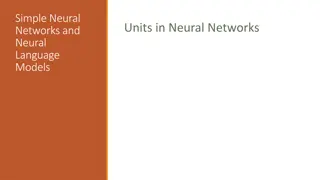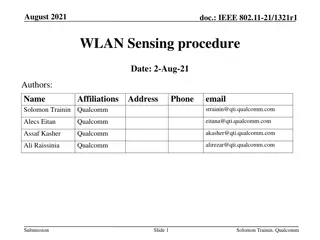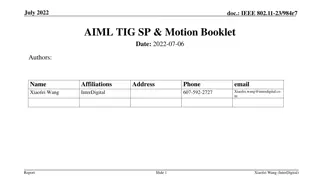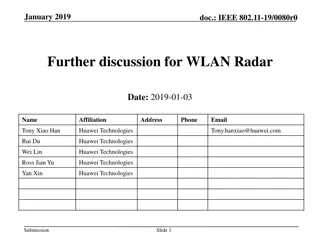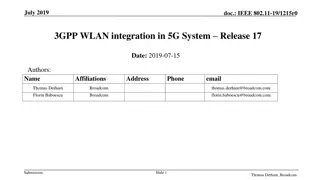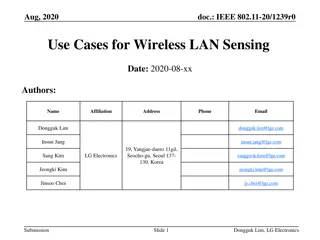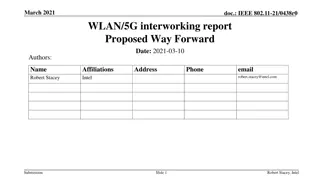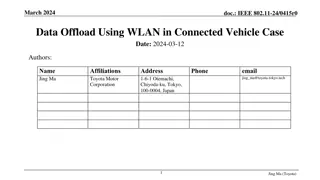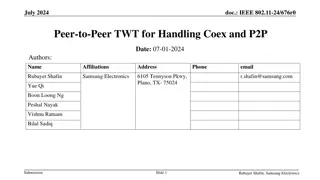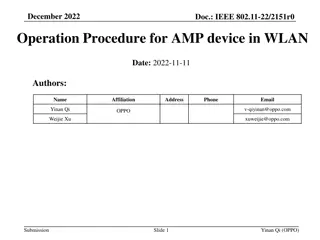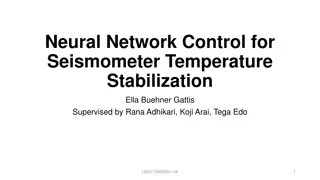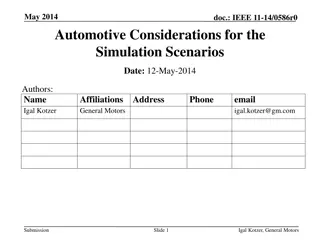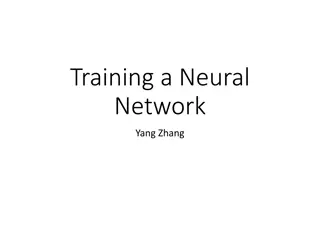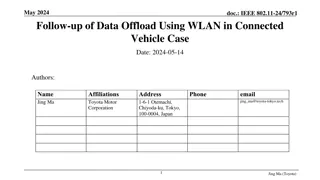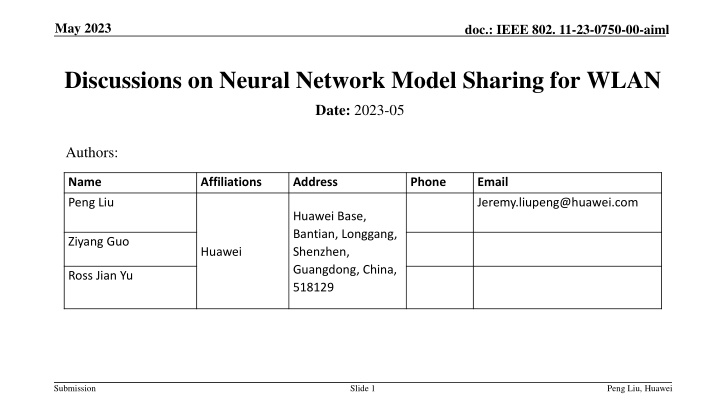
Neural Network Model Sharing for WLAN: Discussions and Use Cases
Explore the discussions on neural network model sharing for WLAN in IEEE 802.11-23-0750-00-aiml, focusing on the sharing between access points (AP) and non-AP stations (STA). Learn about the importance, applications, and benefits of sharing neural network models in wireless local area networks. Dive into use cases, including enhanced roaming, mobility, multi-AP scenarios, latency optimization, and quality of service improvements.
Download Presentation

Please find below an Image/Link to download the presentation.
The content on the website is provided AS IS for your information and personal use only. It may not be sold, licensed, or shared on other websites without obtaining consent from the author. If you encounter any issues during the download, it is possible that the publisher has removed the file from their server.
You are allowed to download the files provided on this website for personal or commercial use, subject to the condition that they are used lawfully. All files are the property of their respective owners.
The content on the website is provided AS IS for your information and personal use only. It may not be sold, licensed, or shared on other websites without obtaining consent from the author.
E N D
Presentation Transcript
May 2023 doc.: IEEE 802. 11-23-0750-00-aiml Discussions on Neural Network Model Sharing for WLAN Date: 2023-05 Authors: Name Affiliations Address Phone Email Peng Liu Jeremy.liupeng@huawei.com Huawei Base, Bantian, Longgang, Shenzhen, Guangdong, China, 518129 Ziyang Guo Huawei Ross Jian Yu Submission Slide 1 Peng Liu, Huawei
May 2023 doc.: IEEE 802. 11-23-0750-00-aiml Introduction Model sharing, one of the main use cases in standardization, has been discussed in AIML TIG [1-3]. In Technical Report [1], model has a broad description and may include specific learning algorithms and parameters. As neural network is a core and symbolic component in AI, and most of the use cases in the survey [4] are related to deep (reinforcement) learning, we focus on neural network model sharing in this submission. Submission Slide 2 Peng Liu, Huawei
May 2023 doc.: IEEE 802. 11-23-0750-00-aiml Neural Network Model Sharing between AP and non-AP STA Neural network model sharing can be applied between STAs (AP and AP, AP and non-AP STA, non-AP STA and non-AP STA), depending on specific use cases. As an example, we focus on the model sharing scenario where AP trains NN models and shares/deploys NN models to non-AP STAs. It looks most likely to be widely used as Training is usually energy consuming and not friendly to battery powered non-APs All non-AP data can be fully utilized for training a model Easy to get a network-level optimization goal Easy for model operation and maintenance (O&M) Facilitate model reuse, one model is applied for multiple non- AP STAs and even multiple features [5]. Train@AP Model deployment/ sharing AP1 AP Training data report Non-AP 3 STA3 STA3 Non-AP 1 Inference@non-AP STA Non-AP 2 STA3 Input Output Neural Network Submission Slide 3 Peng Liu, Huawei
May 2023 doc.: IEEE 802. 11-23-0750-00-aiml Revisit the Use Cases in [6] Related DCN Relevance to the current discussion (neural network model sharing between AP and non-AP STA) Use cases Discussed in AIML TIG 11-23/0433r2 Enhanced roaming/mobility Multi-RU/channel allocation/channel bonding/Multi-AP Latency/QoS optimization Yes NA Yes 11-23/0201r0, 11-23/0227r3 NA, model sharing may be involved between APs NA, seems a scheduling problem, completely implements at AP Traffic prediction NA Device level power consumption AP trains a neural network model for non-AP to determine the power-off time duration 11-22/0979r1 Yes (only mentioned) AP trains a neural network model model for non-AP to determine OBSS ED/CS threshold and power, non-AP infers the SR parameter based on local observation Spatial reuse Yes 11-22/0979r1,11-22/1522r1,11-23/2119r6 AP trains a neural network model model for non-AP to determine channel access decision (CW, transmit probability, or transmit/wait directly) Distributed channel access Channel estimation/MIMO detection NA 11-22/0979r1 Yes (only mentioned) AP trains a neural network model model for non-AP to determine rate/bandwidth/number of spatial streams/power Link adaptation 11-22/0979r1 Yes (only mentioned) AP trains a neural network model model for non-AP to determine beam sector/beamwidth/rate Beam management 11-22/0979r1 MU-MIMO MAC scheduling (user selection and resource allocation) Yes (only mentioned) NA, seems a scheduling problem, completely implements at AP 11-23/0290r1,11-23/1934r5,11- 23/0275r1,11-23/0280r0 Yes AP trains encoder and decoder, and sends encoder to non-AP CSI compression and feedback Submission Slide 4 Peng Liu, Huawei
May 2023 doc.: IEEE 802. 11-23-0750-00-aiml Transmission Scheme Use Cases Most use cases such as device level power consumption, non-AP spatial reuse, distributed channel access, link adaptation and beam management can be categorized as transmission scheme optimization. AP trains neural network models to assist non-AP to determine an optimal transmission scheme. In the following, we discuss neural network model architecture for transmission scheme use cases and look for common ground that facilitates standardization. Submission Slide 5 Peng Liu, Huawei
May 2023 doc.: IEEE 802. 11-23-0750-00-aiml Neural Network Model Workflow for Transmission Scheme Optimization Neural Network (NN) Input Output Channel access power-off time duration OBSS ED/CS threshold MCS Channel ACK Buffer status RSSI Load Neighbor report Pre-processing Format conversion (normalization) to NN model readable format Feature extraction, compress the raw data either NN or other algorithms MAC/PHY measurements Can be a sequence of historical observations Core Neural Network Model structure, e.g., CNN or DNN Layer types, number of layers, number of neurons per layer, activation function Post-processing Map neural network output to specific transmission scheme probability distribution or argmax Transmission scheme Submission Slide 6 Peng Liu, Huawei
May 2023 doc.: IEEE 802. 11-23-0750-00-aiml Discussions on Neural Network Model Workflow The inputs from wireless radio measurements Include local radio measurements at PHY/MAC layer Some parameters have already been defined in Sec.4.3.11 of the 802.11-2020, i.e., Wireless LAN radio measurements May also include customized measurements, not expected to be standardized Could be a sequence of measurements, not only statistics, difficult to be standardized If possible, standardize some basic and common inputs for a variety of use cases. It may have the advantage that AP can obtain some training data (by monitoring non-AP s status) without the report from non-AP STAs, thus reducing the overhead of uploading training data Channel ACK Buffer status RSSI Load Neighbor report A sequence of historical above measurements Submission Slide 7 Peng Liu, Huawei
May 2023 doc.: IEEE 802. 11-23-0750-00-aiml Discussions on Neural Network Model Workflow Pre-processing Format conversion (normalization) to neural network model readable format, e.g., normalized to [0,1] Feature extraction, compress the raw historical observed data from wireless environment Either NN or other algorithms can be applied If Pre-processing is left for implementation, the output of Pre- processing (i.e., the input of core neural network model ) shall be standardized. For example, it could be regulated as a vector with M dimension. In this case, the M-dimensional vector is the training data and shall be reported to AP in order to execute training. M-dimensional vector Submission Slide 8 Peng Liu, Huawei
May 2023 doc.: IEEE 802. 11-23-0750-00-aiml Discussions on Neural Network Model Workflow Core Neural Network Model Layer types, number of layers, number of neurons per layer, activation function If possible, standardize several basic and mandatory model structure such as DNN and CNN Alternatively, employ other standardized neural network model format on top of the 802.11, such as NNEF(Neural Network Exchange Format)[7] and ONNX(Open Neural Network eXchange)[8] Explore model reuse, one neural network model structure applied to multiple transmission scheme optimization use cases, to reduce implementation complexity and facilitate standardization [5]. ???????, dim???????= ? ???????[?] ??????, dim??????= ? ??????[?] Different use cases (rate selection and frame aggregation) with same inputs [4] Submission Slide 9 Peng Liu, Huawei
May 2023 doc.: IEEE 802. 11-23-0750-00-aiml Discussions on Neural Network Model Workflow Post-processing Map neural network output to specific transmission scheme Post-processing can be categorized as two types based on the output of Core NN model Type A. if Core Neural Network model outputs a probability distribution. Take MCS selection as an example, it corresponds to the probability distribution of each MCS, and post-processing randomly outputs one MCS based on the probability distribution Type B. if Core Neural Network model outputs scores of transmission scheme. Again, take MCS selection as an example, it corresponds to the score of each MCS, and post-processing outputs one MCS whose score is the maximum Both two types of post-processing can be considered to be standardized to support a variety of AI algorithms Channel access power-off time duration OBSS ED/CS threshold MCS N-dimensional vector Probability distribution Scores Submission Slide 10 Peng Liu, Huawei
May 2023 doc.: IEEE 802. 11-23-0750-00-aiml Summary of Neural Network Model Workflow Components Descriptions Thoughts on Standardization Standardize some basic and common inputs for a variety of use cases The inputs local radio measurements at PHY/MAC layer, defined in Sec.4.3.11 of 802.11-2020 or customized Can be a sequence of historical observations If Pre-processing is left for implementation, the output of Pre-processing (i.e., the input of core NN model ) shall be standardized Pre-processing Format conversion (normalization) to NN model readable format Feature extraction, compress the raw data either NN or other algorithms Standardize several basic and mandatory model structure such as DNN and CNN Alternatively, consider ONNX or NNEF on top of the 802.11 Explore Model reuse Core Neural Network Model Structure, e.g., DNN or CNN Layer types, number of layers, number of neurons per layer, activation function Both two types can be considered to be standardized Post-processing Map Neural Network output to specific transmission scheme probability distribution or ArgMax Submission Slide 11 Peng Liu, Huawei
May 2023 doc.: IEEE 802. 11-23-0750-00-aiml Summary In this contribution, we discussed some general considerations on neural network model sharing for WLAN. We revisit the use cases in the previous submission and observe that most of them can be categorized as transmission scheme optimization. We investigate the neural network model architecture on transmission scheme optimization use cases, which consists of inputs, pre-processing, core neural network model and post-processing, and discuss the functions and possible standardization impacts/ways for each part. Submission Slide 12 Peng Liu, Huawei
May 2023 doc.: IEEE 802. 11-23-0750-00-aiml Reference [1] 11-23-0397-01-aiml-technical-feasibility-analysis-of-ml-model-sharing [2] 11-22-1948-00-aiml-aiml-model-sharing-use-case [3] 11-23-0397-01-aiml-technical-feasibility-analysis-of-ml-model-sharing [4] S. Szott, K. Kosek-Szott, P. Gaw owicz, J. Torres G mez, B. Bellalta, A. Zubow and F. Dressler, "Wi-Fi Meets ML: A Survey on Improving IEEE 802.11 Performance with Machine Learning," in IEEE Communications Surveys & Tutorials, doi: 10.1109/COMST.2022.3179242. [5] 11-23-0075-01-0uhr-more-discussions-on-deep-learning-for-wlan [6] 11-22-0458-01-0wng-looking-ahead-to-next-generation-follow-up [7] The Khronos NNEF Working Group, Neural Network Exchange Format , https://www.khronos.org/registry/NNEF/specs/1.0/nnef-1.0.5.html [8] Open Neural Network Exchange (ONNX), https://onnx.ai Submission Slide 13 Peng Liu, Huawei




